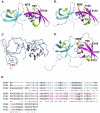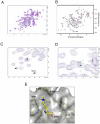Structural studies of the tandem Tudor domains of fragile X mental retardation related proteins FXR1 and FXR2
- PMID: 21072162
- PMCID: PMC2970552
- DOI: 10.1371/journal.pone.0013559
Structural studies of the tandem Tudor domains of fragile X mental retardation related proteins FXR1 and FXR2
Abstract
Background: Expansion of the CGG trinucleotide repeat in the 5'-untranslated region of the FMR1, fragile X mental retardation 1, gene results in suppression of protein expression for this gene and is the underlying cause of Fragile X syndrome. In unaffected individuals, the FMRP protein, together with two additional paralogues (Fragile X Mental Retardation Syndrome-related Protein 1 and 2), associates with mRNA to form a ribonucleoprotein complex in the nucleus that is transported to dendrites and spines of neuronal cells. It is thought that the fragile X family of proteins contributes to the regulation of protein synthesis at sites where mRNAs are locally translated in response to stimuli.
Methodology/principal findings: Here, we report the X-ray crystal structures of the non-canonical nuclear localization signals of the FXR1 and FXR2 autosomal paralogues of FMRP, which were determined at 2.50 and 1.92 Å, respectively. The nuclear localization signals of the FXR1 and FXR2 comprise tandem Tudor domain architectures, closely resembling that of UHRF1, which is proposed to bind methylated histone H3K9.
Conclusions: The FMRP, FXR1 and FXR2 proteins comprise a small family of highly conserved proteins that appear to be important in translational regulation, particularly in neuronal cells. The crystal structures of the N-terminal tandem Tudor domains of FXR1 and FXR2 revealed a conserved architecture with that of FMRP. Biochemical analysis of the tandem Tudor domains reveals their ability to preferentially recognize trimethylated peptides in a sequence-specific manner.
Enhanced version: This article can also be viewed as an enhanced version in which the text of the article is integrated with interactive 3D representations and animated transitions. Please note that a web plugin is required to access this enhanced functionality. Instructions for the installation and use of the web plugin are available in Text S1.
Conflict of interest statement
Figures





References
-
- Turner G, Webb T, Wake S, Robinson H. Prevalence of fragile X syndrome. Am J Med Genet. 1996;64:196–197. - PubMed
-
- Warren ST, Nelson DL. Advances in molecular analysis of fragile X syndrome. JAMA. 1994;271:536–542. - PubMed
-
- Verkerk AJ, Pieretti M, Sutcliffe JS, Fu YH, Kuhl DP, et al. Identification of a gene (FMR-1) containing a CGG repeat coincident with a breakpoint cluster region exhibiting length variation in fragile X syndrome. Cell. 1991;65:905–914. - PubMed
-
- Kenneson A, Zhang F, Hagedorn CH, Warren ST. Reduced FMRP and increased FMR1 transcription is proportionally associated with CGG repeat number in intermediate-length and premutation carriers. Hum Mol Genet. 2001;10:1449–1454. - PubMed
Publication types
MeSH terms
Substances
Grants and funding
LinkOut - more resources
Full Text Sources
Molecular Biology Databases
Research Materials

